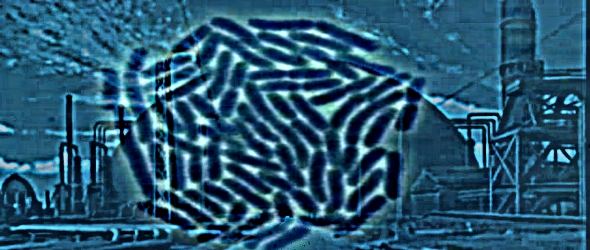BY LETTER
Vat-Tech
Technology > Application > Manufacturing
Technology > Technology Levels > Middle Tech / Midtech
Technology > Technology Type or Material > Organic/Biotech
Technology > Technology Levels > Middle Tech / Midtech
Technology > Technology Type or Material > Organic/Biotech
 Image from Steve Bowers |
Vat-tech is an Information Age technology for creating useful materials from cell cultures. The earliest applications were in the growth of artificial meat, but other high-value materials were not far behind. Animal tissue cultures naturally led to the artificial production of ivory, horn, furs, leather, wool, shell, chitin, silk, beeswax, and precious coral or opalescent silica. Plant cultures produced vatwood or vatbamboo (initially in the form of luxury or precious woods such as ebony, rosewood, mahogany, or sandalwood) or plant fibres of various kinds.
The first vat-products were rare and specialty items, but the price per kilogram steadily dropped in the decades after the technology was first introduced. On the one hand, the nutrient feeds and artificial supports for these cell cultures were expensive, but on the other hand the high quality and uniformity of the product, the efficiency of the material and energy inputs (minimal waste material that needed to be disposed of) and, in the case of the animal products, the complete freedom from the practical and ethical difficulties of raising and slaughtering livestock, proved to be great advantages. Advertisers promoted the 'dream house with a gate of horn and a gate of ivory'. Bulk coral and shell began to take the place such materials as concrete, while construction-grade wood or cork from vats became economically competitive with material harvested from trees, and cloth and paper products were grown directly rather than created from plant fibre inputs. The practice of growing entire structures was still well in the future, and did not emerge until First Federation times, but growing the construction materials in bionanotech vats prior to assembly became common practice.
The initial dominance of vat-produced products was challenged somewhat later in the Information Age by the rise of plants or fungi gengineered to produce the desired products, including products previously derived only from animals or from vat-tech cell cultures. Deliplants, meatshrooms, hornwoods, and fur trees were just a few of the early entries into the markets of the day. As these organisms required no more infrastructure than a standard farm or greenhouse, and could be propagated from seeds and cuttings, the cost to acquire and maintain them was quite low. However, even at the height of the later Dark Ages, when simple and robust systems requiring little infrastructure were at a premium, vat-tech retained its place for bulk applications.
Vat-tech survived a similar challenge in the Golden Age when the first inexpensive and reliable nanofacs able to produce good facsimiles of natural organic materials became available. While nanofacs did replace vat-tech for shaped items, vat-tech was retained for the creation of bulk lots of materials. Some societies abandoned nanofacs entirely after the Technocalypse as being too dangerous and unreliable, bringing about a rebound of vat-tech, but even when the cloud over nanotech use lifted in the First Federation vat-tech retained its niche.
Finally, the advent of seed-tech and sporetech organisms (gengineered, bionano, hylonano or synano) that simply grow into a finished product, without the intermediary step of assembly, had an impact on the demand for bulk vat-produced components, but such organisms are adapted to a narrow range of habitats, have some limitations because of the fact that they must grow, and may be difficult to modify to the tastes of a particular prospective owner. Again, there are many situations in which it is better to assemble an object from vat-grown components.
In the times since its first introduction, the range of vat-tech use has expanded to the cultivation of neogen and cytobot cell cultures, capable of producing a huge range of products, organic and otherwise. Modern vat-tech may produce almost any sort of material, and may employ anything from mildly gengineered biont cells to highly advanced microsynanobots.
Related Articles
- Artificial Meat Production
- Biobots
- Biochemist
- Bioforge
- Biomachine
- Biomeso - Text by M. Alan Kazlev
Biological mesotech; like bionano but on a meso- rather than a nano- scale. - Bionanecology
- Bionano, Bionanotechnology
- Hylonano - Text by Todd Drashner
Molecular Nanotechnology (dry nanotech). Use of artificially created non-biomolecular systems as replicators, assemblers, or components of molecular nanotechnology; any molecular nanotechnology not based on bio-molecules or biotech. Sometimes referred to as "Drexlerian nanotech". - Seedtech
- Synano - Text by Stephen Inniss
Nanotechnology that integrates hylonano ("dry", or inorganic nanotech) with bionano ("wet", or organic nanotech).
Appears in Topics
Development Notes
Text by Stephen Inniss
Initially published on 18 October 2010.
Initially published on 18 October 2010.






